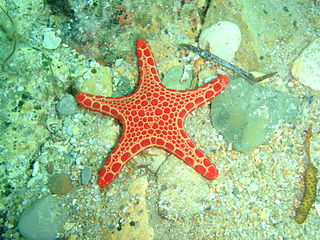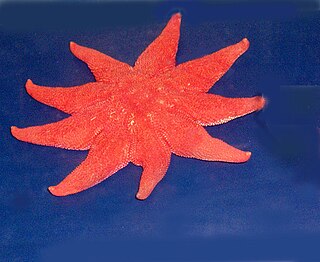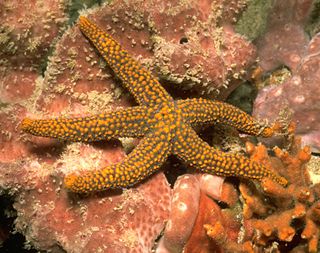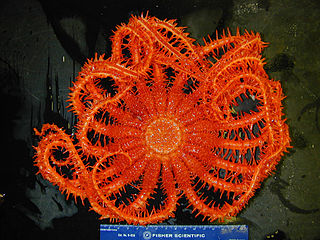
Asterias is a genus of the Asteriidae family of sea stars. It includes several of the best-known species of sea stars, including the (Atlantic) common starfish, Asterias rubens, and the northern Pacific seastar, Asterias amurensis. The genus contains a total of eight species in all. All species have five arms and are native to shallow oceanic areas of cold to temperate parts of the Holarctic. These starfish have planktonic larvae. Asterias amurensis is an invasive species in Australia and can in some years become a pest in the Japanese mariculture industry.

Asterias amurensis, also known as the Northern Pacific seastar and Japanese common starfish, is a seastar found in shallow seas and estuaries, native to the coasts of northern China, Korea, far eastern Russia, Japan, Alaska, the Aleutian Islands and British Columbia in Canada. Two forms are recognised: the nominate and formarobusta from the Strait of Tartary. It mostly preys on large bivalve molluscs, and it is mostly preyed on by other species of starfish. Population booms in Japan can affect the harvest of mariculture operations and are costly to combat.

The Echinasteridae are a family of starfish in the monotypic order Spinulosida. The family includes eight genera and about 133 species found on the seabed in various habitats around the world.

Solaster paxillatus, the orange sun star, is a species of starfish found at varying depths in the northern Pacific Ocean. It is a natural predator of the starfish Asterias amurensis.

Goniasteridae constitute the largest family of sea stars, included in the order Valvatida. They are mostly deep-dwelling species, but the family also include several colorful shallow tropical species.

The Forcipulatida are an order of sea stars, containing three families and 49 genera.

Henricia is a large genus of slender-armed sea stars belonging to the family Echinasteridae. It contains about fifty species.

Solaster is a genus of sea stars in the family Solasteridae.

Asterias forbesi, commonly known as Forbes sea star, is a species of starfish in the family Asteriidae. It is found in shallow waters in the northwest Atlantic Ocean and the Caribbean Sea.

Evasterias troschelii is a species of starfish in the family Asteriidae. Its common names include the mottled star, false ochre sea star and Troschel's true star. It is found in Kamchatka and the north western coast of North America.

Echinaster spinulosus, the small spine sea star, is a species of sea star found in shallow parts of the western Atlantic Ocean, the Caribbean Sea and Gulf of Mexico.

The Brisingidae are a family of starfish found only in the deep sea. They inhabit both the Atlantic and Pacific Oceans at abyssal depths, and also occur in the Southern Ocean and around Antarctica at slightly shallower depths.

The Freyellidae are a family of deep-sea-dwelling starfish. It is one of two families in the order Brisingida. The majority of species in this family are found in Antarctic waters and near Australia. Other species have been found near New Zealand and the United States.

Pteraster is a genus of sea stars in the family Pterasteridae.

Freyella elegans is a species of deep-water starfish in the family Freyellidae in the order Brisingida, living at abyssal depths in the northwestern Atlantic Ocean.

Coscinasterias muricata is a species of starfish in the family Asteriidae. It is a large 11-armed starfish and occurs in shallow waters in the temperate western Indo-Pacific region.

Asterias rollestoni is a common starfish native to the seas of China and Japan, and not known from the far north or the American coasts of the eastern Pacific.
Asterias rathbuni is a starfish native to the Pacific coasts of Alaska in the United States and Far East Russia. There are two subspecies.
Asterias argonauta is a starfish native to the Pacific coasts of Far East Russia.
Pseudarchaster is a genus of echinoderms belonging to the family Pseudarchasteridae.















